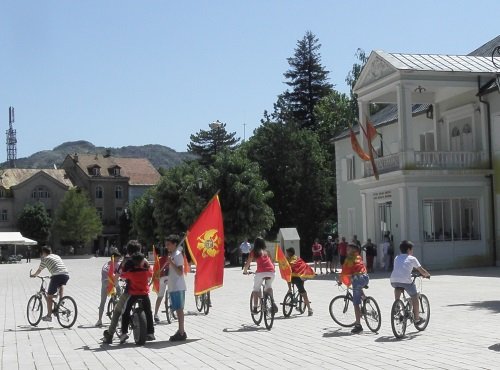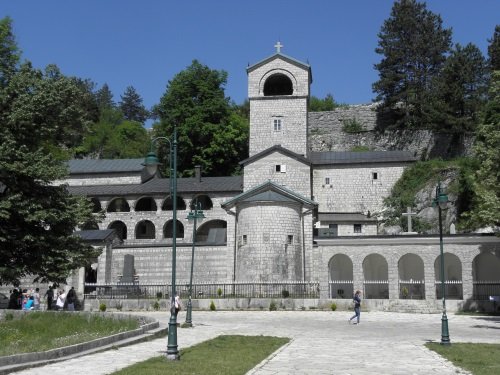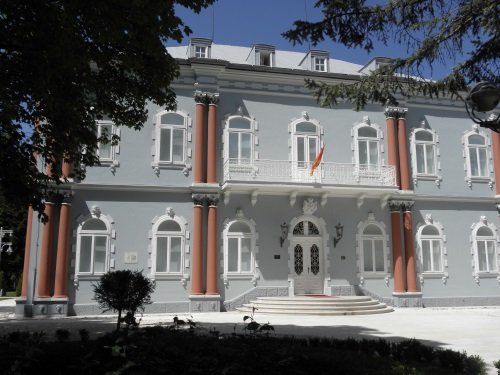Montenegro made a sudden appearance on the international political scene this week as it was
asked to become a member of the NATO
. The move steers it away from the Russian sphere of influence, which it was a part of essentially until independence from Serbia in 2006. So far this small Balkan country holds 2 WHS, both 'inherited' from former Yugoslavia. At the WHC session of 2016 it hopes to double this number with the transboundary site of the
Stecci Medieval Tombstones
and on its own steam with the old capital
Cetinje
.

|
|
Kids celebrating Independence Day
|
Cetinje was the Royal Capital of Montenegro from the 15th century until Montenegro's incorporation in Yugoslavia after WWII. In the early 20th century it was the world's smallest capital, registering only 5,895 inhabitants. It is considered both a cradle of Montenegrin culture and a Serbian Orthodox religious center. The official residence of the Montenegrin President is still located here.
I visited Cetinje in 2013, on my way between Podgorica and
Kotor
. Buses between the two cities will make a stop in Cetinje, so it's an easy break. It's also within reach of the popular beach resort of Budva and its tour bus-daytrippers (you'll surely encounter them). I walked around the historic center for 1.5 hours, and was really surprised about the good state of most of the monuments. Especially the villas and old embassies are worth seeing. The town has a Central European feel, a bit like
Kutna Hora
or
Cesky Krumlov
in the Czech Republic. It happened to be Independence Day, so the atmosphere was particularly festive.

|
|
Cetinje Serbian-Orthodox Monastery
|
Most people come to see the Cetinje Monastery, which is the seat of the highest and largest diocese of the Serbian Orthodox Church in Montenegro. Its church holds an important relic: the right hand of Saint John the Baptist! It would be a fine addition to our '
Relics from the John the Baptist
'-connection. The right hand is especially sacred as it is the one with which he supposedly baptised Jesus - besides Cetinje monastery, the Topkapi Palace in
Istanbul
and the Romanian skete of the Forerunner on
Mount Athos
claim to have it as well. Unfortunately I did not get to see it, as I didn't feel like waiting around with dozens of other foreign tourists in the inner courtyard for a group visit to start.
Cetinje was named after the River Cetina that runs through it. Its historic core seems to be frozen in time, because it developed quickly during the short period between the seventies of the nineteenth century until the First World War. After Montenegro’s independence was recognized during the
Berlin Congress of 1878
, foreign architects added many modern buildings to the cityscape to serve as consulates. “The buildings of the French, Russian, British, Italian and Austro-Hungarian consulates are regarded as the most beautiful of these”, according to the Wikipedia-page for Cetinje.
I found the residence of the President of Montenegro its most impressive building. It is actually a similarly colourful villa as the old embassies, called the "Blue Palace". It also dates from the late 19th century, when it was the palace of the Crown Prince of Montenegro.

|
|
Blue Palace, residence of the President
|
In the not particularly convincing summary of the nomination file that I managed to get my hands on, Montenegro aims for inclusion on criteria ii (“A veritable meeting point of cultural influences”), iii (town planning) and vi. The latter criterion is the most specific: “the Centre keeps three important Christian relics which include the famous icon of Our Lady of Phileremo; it is here that in the end of the 15th century the first book was printed in Cyrillic by the Crnojević Printing House”. But we can’t have a WHS solely on criterion vi, so the others would have to convince ICOMOS and the WHC.
While we’re currently working our way through the categories looking for the best WHS, I’m afraid Cetinje wouldn’t stand a chance among the
Urban Planning
or
Post-medieval European
entries. Nice enough for a detour and of regional significance, but WH material?



